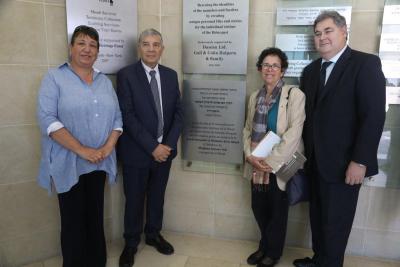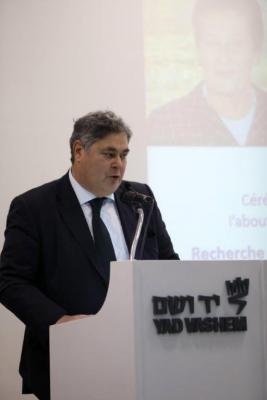26 October 2017
Today, Yad Vashem, the World Holocaust Remembrance Center, and the Foundation for the Memory of the Shoah (Fondation pour la Mémoire de la Shoah) held a joint event marking the conclusion of a decade-long project collecting names of Holocaust victims from Hungary. This major project was funded by the Foundation and supported by the late Simone Veil, who was appointed as its first President. The event included a special tribute to Veil, who passed away earlier this year.
Long-term supporter of Yad Vashem and world-renowned Holocaust historian and Holocaust survivor Serge Klarsfeld also recognized the importance of collecting the names of Hungarian victims of the Holocaust. In the 1980s, Klarsfeld launched the Nevek Project, gathering names from lists of prisoners of forced labor and concentration camps during WWII. The Project resulted in numerous volumes listing Hungarian Jews persecuted and murdered during the Shoah. This was the largest source of names of Hungarian victims before Yad Vashem embarked on the latest names collection endeavor. Klarsfeld, who now serves as a trusted advisor to the current President of the Foundation for the Memory of the Shoah David de Rothschild, supported this endeavor from its outset.
Yad Vashem Chairman Avner Shalev stated: "Simone Veil saw special importance in the collection of names of Hungarian Jews. She witnessed first-hand the arrival and extermination of Hungary's Jews at Auschwitz-Birkenau. It was important to her that their identities be memorialized and therefore decided to support this important initiative." Shalev continued: "In fact, this is the most successful project that Yad Vashem's Archives has undertaken. The holistic approach of the project has become a model for other endeavors we are currently promoting in the name-gathering process, in particular the Polish Names Project, and we hope that with the continued support of the French Foundation we will achieve similar results to those we obtained in collecting names of Jewish victims from Hungary." Yad Vashem has also applied this process to its names recovery efforts in the territories of the former Soviet Union and the Balkan States.
Simone Veil, former French politician and Holocaust survivor, was a driving force behind groundbreaking Holocaust commemoration, documentation and education in France, Europe and around the world. Veil was a close friend and supporter of Yad Vashem and on many occasions visited its campus. Under her guidance, the French Foundation for the Memory of the Shoah funded many Yad Vashem activities and projects. The Hungarian names project is one of the largest and longest running of its projects. Simone's son and current President of the French Committee for Yad Vashem (Comité Francais pour Yad Vashem), Pierre-François, attended and spoke at today's event:
“The images of the tragic fate that befell the hundreds of thousands of Jewish men, women and children from Hungary, as depicted in the photos in the infamous Auschwitz Album and which my beloved mother witnessed first-hand, remained and haunted her throughout her life. It is due to that memory of those terrible days in Birkenau that Mom wished to support this project to find and record their names for posterity. I know that today her pain would be assuaged by this immense achievement.”
80% of the total number of Hungarian Holocaust Victims have now been identified
"Some 600,000 Jews from Greater Hungary were murdered during the Holocaust," explained Dr. Alexander Avram, Director of the Hall of Names and the Central Database of Shoah Victims' Names at Yad Vashem. "This number represents approximately one out of every ten victims of the Holocaust and one in every three victims of the gas chambers at Auschwitz-Birkenau, where the overwhelming majority of deported Hungarian Jews were sent. Approximately ten years ago, Yad Vashem embarked on a critical project to map, copy, catalogue and record the names and personal data of Hungarian Holocaust victims. The project of systematically collecting the names of Hungarian victims of the Shoah began in 2007. At the outset of the project, only some 260,000 names were known (representing less than 40% of the total victims from Hungary); after years of intensive work and research, most of the names of the Hungarian Jewish victims – close to 500,000 names (80% of the total number of victims) have been accounted for. Furthermore, the project has uncovered much more than just the names of the Hungarian victims; it has revealed part of their individual stories, and in some cases, for the first time was able to connect a rare photograph with the name of the faceless murdered."
Dr. Haim Gertner, Director of the Yad Vashem Archives and Fred Hillman Chair for Holocaust Documentation reflected: "The project was coordinated by experts in Yad Vashem and supported by two professional teams abroad: one team in Hungary, led by two renowned experts with 12 researchers; and another group in Transylvania, led by a well-known expert with three researchers. The privacy laws in Hungary changed at the outset of the project providing full access to all relevant information throughout Hungary, but we knew that under different circumstances this could reverse."
During the project, Yad Vashem copied 2,463,000 pages of documentation and catalogued almost 170,000 files, expanding its current Archives with a plethora of information about the Jewish communities that once existed and thrived in Hungary. However, the success of this project uncovered much more than a list of names.
Yad Vashem Archives
The Yad Vashem Archives houses the world's most comprehensive collection of Holocaust-era documentation. Ongoing efforts including the yearly scanning of some one million pages of documentation have made much of the archival collections accessible to the public – thus exposing a wealth of information gathered by Yad Vashem to an ever-growing worldwide audience. Recent agreements facilitating the sharing of information with various international archives have further propelled the growth of the Archives holdings, which now include some 201 million pages of documentation.









